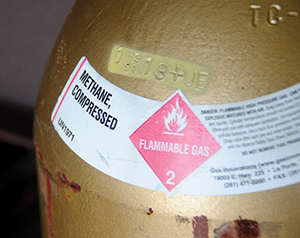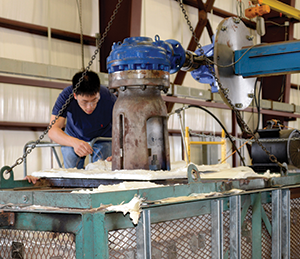A Primer on Fugitive Emissions
Fourscore and seven years ago, no one had ever heard the term “fugitive emissions.” Today, many people wish they’d never heard the expression.
#basics
Fugitive emissions (FE) have nothing to do with gifts left by toddlers in their diapers overnight, although “volatile” chemical compounds are involved. In the world of industry, FEs are undesired releases of hazardous or environment-damaging gases from mechanical equipment including flanged connections, pumps, compressors, storage tanks and valves found in refineries, chemical plants, pipelines, wellheads and even some sewage treatment plants.
The initial push for clean air that got the ball rolling in U.S. industrial plants resulted from the killer “Donora Smog,” which afflicted a small Pennsylvania steel mill town in October of 1948. Donora is a steel manufacturing community near Pittsburgh that was home to many industries pouring out tons of pollutants into the atmosphere every year. The fog, which was a mixture of unmoving toxic gases and moisture, sat over the town of Donora for about five days. Before the week was out, 20 persons were dead and thousands were sick from the ugly noxious air.
The Donora incident led to the creation of the first clean air program in the U.S., although its initial focus was the metals industry. The Clean Air Act, addressing air pollution, would be created in 1963. It has been amended and toughened up several times since its inception. The Environmental Protection Agency (EPA) was created under the Nixon administration in 1970 as the department to direct the country’s clean air and water efforts in the United States.
Linear Valves: Worst Offenders
As far as valves, the emissions are released through two primary sources: gasketed-joints and packing systems. The biggest offenders are linear valves (gates and globes), which use a rising or rising and rotating stem motion through a packing system. This rising and rubbing motion is harder to seal properly than the short, 90-degree rotary motion of a stem in a quarter-turn valve. Gasketed joints are somewhat easier to seal since the seal is static.
Because linear valves are cost-effective flow control devices, particularly for on-off service, they are present in large numbers in nearly all refineries and chemical plants. This means that fugitive emissions control in linear valves is receiving a huge amount of attention.
Why is controlling fugitive emissions in linear valves difficult? Most of today’s premium low-emission (low-E) packings have been tested in accordance with the American Petroleum Institute’s (API) Standard 622, Type Testing of Process Valve Packing for Fugitive Emissions. The tests consist of mechanical and temperature cycles, while the candidate packing is contained in a precision-machined test fixture. These graphite-based packings usually do very well in testing, with leakage rates well below 100 parts per million (ppm). The real test occurs when an API 622 tested packing is installed and tested in an actual valve. For linear valves, this test is API 624, Type Testing of Rising Stem Valves Equipped with Graphite Packing for Fugitive Emissions. (For quarter-turn valves, the test standard is API 641, Type Testing of Quarter-turn Valves for Fugitive Emissions).
CRITICAL FIT & FINISH
Alignment of the bushings above and below the packing also is critical for sealing success. The upper bushing/bearing, which is called the stem bushing, must be machined in perfect alignment with the packing gland area. The second bushing, which is the backseat bushing, is found below the packing area. It, too, must be aligned perfectly with both the packing gland area and the handwheel bushing.
The best low-E packing in the world will fail to contain potential emissions if tight tolerances between all these components are not met. This means repeatability in manufacturing is even more critical for valves in low-E applications: Only time will tell if this component machining repeatability issue will be successfully met.
When all the components are in correct alignment and within tolerance, the next consideration is that low-E packing must be installed correctly. Low-E packings generally require a lot more torque to seal than non-low-E types, and the packing manufacturer’s instructions must be followed to the letter.
FE TESTING
For a manufacturer to qualify his line of valves as “low-E compliant,” the design must be verified through the testing of prototype valves. In the U.S., this testing is performed with methane gas. Testing with elevated temperature methane carries some risks, but the EPA currently only recognizes results performed with methane. In Europe and some other parts of the world, type testing is performed with helium in accordance with the International Organization for Standardization’s ISO 15848-1, Industrial Valves−Measurement, Test and Qualification Procedures for Fugitive Emissions. While ISO 15848 recognizes methane testing, no direct correlation exists between helium and methane leakage. That fact bears repeating—there is no correlation between methane leakage rates and helium leakage rates.
Just recently, API published its API 641 quarter-turn testing document. It is fundamentally different from the linear testing document (API 624) in that it covers testing of elastomers and also has a range of test temperatures. Passing the API 641 test procedure is expected to be much easier because of the limited amount (90-degree) of stem movement.
CONSENT DECREES
A buzzword in the valve industry these days is “consent decree.” A consent decree means the EPA has found a plant guilty of exceeding the emissions amounts it should be releasing and must make changes to stay in business. An analogy would be this: You take permanent markers away from your four-year-old (who has just re-painted the kitchen floor) and sternly say that: “from now on you must use erasable markers if you are going to paint. And you better not paint the floor anymore either or you will be in big trouble!”
Consent decrees usually dictate specific steps that must be taken by the offending plant to keep operating. As far as valves go, they may require testing of all new valves or they may require a change in valve designs to meet the best available control technology. Included in many of these consent decrees is the requirement that valves be guaranteed to meet low-E requirements for a period of five years. This five-year warranty requires a confident valve manufacturer that is also very comfortable with its packing vendor.
Because of advancements in detection technology, the EPA now can use mobile plant-perimeter monitoring systems to detect in-plant leakage from outside the fence. If suspected leakage is observed, a detailed component specific test is then performed in the plant to confirm the actual leakage rate.
THE EPA LOOKS UPSTREAM
Until recently, valve FE control has focused on the downstream refinery sector as well as petrochemical and chemical plants. Now, the EPA is looking at upstream and midstream applications as well. This new focus includes wellheads and pipeline valves, which have been exempt from FE inspection until now.
Linear pipeline gate valves manufactured under the API 6D design standard will now have to face the same issues that refinery gate valves have overcome. The ambient operating temperature of these valves and their use of non-graphite packings should help; however, this study and implementation of any necessary design changes is just beginning.
Wellheads face a unique set of problems. While they generally operate at ambient temperatures, the pressures required to contain them under operating conditions and especially under 1.5X operating pressure testing is hard to contain if a gas such as methane or helium is used as the test fluid. At more than 10,000 psi pressures, the helium will permeate the elastomeric seals and show leakage, and at those pressures, testing with methane is too dangerous. As a result, the upstream wellhead industry is looking into the feasibility of testing with argon if they can correlate the leakage rate of argon to that of the EPA-approved methane.
WHAT NEXT?
Although the EPA has focused on the chemical, petrochemical and refining industries, other industries may be just over the agency’s horizon. The wastewater industry, with its methane-gas-rich sewage treatment plants, could possibly be the next EPA target.
But while much grumbling about the EPA and their regulations occurs, those who have lived in the Gulf Coast area have seen a big difference in the days before and after regulation. As a life-long resident living within a dozen miles of the Houston area petrochemical complex, I can report that it used to be the best way to tell the wind direction at home was to go outside and smell. Today, the air around those plants is clear, and I need to consult the weather forecast to determine the correct wind direction.
GREG JOHNSON is president of United Valve (www.unitedvalve.com) in Houston. He is a contributing editor to VALVE Magazine, a past chairman of the Valve Repair Council and a current VRC board member. He also serves as chairman of VMA’s Education & Training Committee, is vice chairman of VMA’s Communications Committee and is past president of the Manufacturers Standardization Society. Reach him at greg1950@unitedvalve.com.
A summary of the issues
- Linear valves are harder to seal than quarter-turn valves.
- API 622 is the graphite packing testing standard.
- API 624 is the linear valve FE testing standard.
- API 641 is the quarter-turn FE testing standard.
- ISO 15848-1 is the ISO (generally non-U.S.) FE valve testing standard.
- Methane gas is used as the test gas in the U.S.
- Helium gas is used in other parts of the world as a test gas.
- Helium leakage cannot be correlated with methane leakage.
- Dimensions and tolerances must correct for low-E valve packings to work.
- Consent decrees are agreements between the EPA and offending plants, dictating what steps must be followed to correct emissions problems.
- The industry is currently aiming for 100 ppm maximum leakage.
- Pipeline valves and wellheads are now being scrutinized for FE leakage.
- Very high pressure (above 10,000 psi) methane or helium gas testing is problematic.
RELATED CONTENT
-
Ancient Roman Valves
The story of water supply in the ancient Roman Empire is grand.
-
Ball Valve Basics
Welcome to the first in a series of Valve Basics articles, each focused on a major product type and written especially for newcomers to the industries that use and make valves and related products.
-
Understanding Torque for Quarter-Turn Valves
Valve manufacturers publish torques for their products so that actuation and mounting hardware can be properly selected.












 Unloading large gate valve.jpg;maxWidth=214)